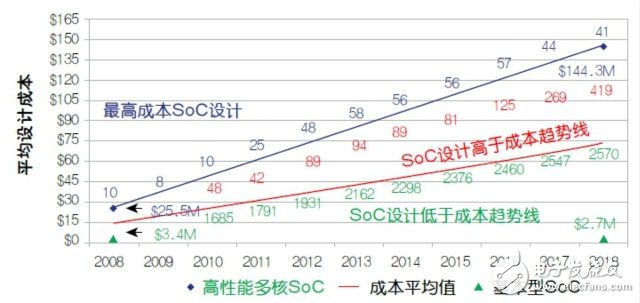Let us face it. In fact, every technology company is confused, or more accurately, the huge number of IoT markets that are predicted by the industry. According to Cisco's forecast, "50 billion devices will be connected to the Internet by 2020."
I am not prepared to argue the right or wrong of the prediction. But I would like to know what this prediction will reflect in the SoC market.
The reporter recently interviewed Richard Wawrzyniak, senior market analyst at Semico Research, to see how the promise of the IoT market will affect SoC's prospects.

Richard Wawrzyniak, Senior Market Analyst, Semico Research
As Wawrzyniak sees, every chip supplier that is currently cultivating the IoT market has chosen “one or two niche markets†that they believe will be profitable.
Unlike the smartphone application processor, even with such things, it is impossible to meet all the needs of the IoT SoC platform. After all, the Internet of Things is a very diverse and segmented market.
The three building blocks that are considered to be clearly necessary in IoT terminal devices are sensors, MCUs, and wireless connections.
Wawrzyniak's colleague and Semico's chief technology officer Tony Massimini publicly stated that in addition to this, the indispensable elements driving the IoT market are "power management, algorithms (sensor fusion) and embedded security."
Deceptive concept?
"The concept of 'must use ultra-cheap chips' to start the Internet of Things is deceptive," Wawrzyniak said.
He explained that after taking a cheap route, some potentially critical factors will be discarded, such as what some consider to be a key security factor. In some IoT device use cases, a WiFi connection is also necessary.
In recent months, you may have noticed that the media is discussing more about the Industrial Internet of Things (IIoT). The Internet of Things industry may be soberly aware of the fact that the family Internet of Things is actually the most difficult piece of bone.
If a family has 30 networked devices (not just networked light bulbs, there are everything else) running 70 separate applications, the inevitable question is who will maintain and manage the network, Wawrzyniak said.
Unlike the Industrial Internet of Things, where there is a budget for professionals to manage the network, there will not be too many family owners who are willing to ask for a home-based IoT manager, he explained.
This is one reason why the cost of some consumer IoT devices in the SoC will eventually rise, Wawrzyniak pointed out. For example, all of these networked devices are not always non-intelligent endpoints. Some devices need to provide a graphical user interface to allow users to access IoT devices and understand how to use them, the analyst said.
There is another thing to consider, Wawrzyniak added. If we discuss a stand-alone IoT device, such as a door handle or thermostat, at one point in the house, that's fine. But once the device is connected to other devices, the entire home becomes a "system", he reminded.
Wawrzyniak believes that what matters is how deeply networked devices are embedded in the network. This is a very important issue, Wawrzyniak said, because it will change the nature and architecture of the IoT SoC.
At the time of the popularity of IoT SoCs, Wawrzyniak is considering a new category beyond the three SoCs currently defined by Semico, SoC solutions specifically for IoT purposes. The current three categories include: high-performance multi-core SoC; high-value multi-core SoC; basic SoC.
He acknowledged that the increase in the IoT SoC category is much more complicated than it seems, because SoCs created for IoT solutions are easy to relate to other applications. Similarly, existing SoC classifications can share certain characteristics with the Internet of Things category.
There is still much to be done to define the IoT SoC, he said. Perhaps more importantly, identify features and technologies that are “unique for IoT applications,†he added.
Increasing SoC design costs
One of the reasons why Semico insists on dividing SoCs into different categories is that it can help people understand the trend line of the semiconductor market and new chip design more clearly.
Like the other industry analysts, Semico's Wawrzyniak is very concerned about the rising SoC design costs.
In a Semico report published in March this year titled "SoC Wafer and Software Design Cost Analysis: How Rising Costs Affect SoC Design Startup," Wawrzyniak said that the design cost of silicon and software work will be by 2018. The compound annual growth rate (CAGR) of 43.7% increased.
As the report warns, Wawrzyniak points out that what the industry really needs to pay attention to is the substance of the superficial article.
Just the rise in the cost of a class of SoCs may give the semiconductor industry and the economic market the impression that the semiconductor industry is going to collapse. Simply look, the cost rises at this rate, and no one can afford the design of the new chip.
not true
In addition to rising SoC design costs, Wawrzyniak recommends looking at the actual number of design launches for different SoC types.

Cost distribution map for the first SoC design
The lines in the above picture show the increasing cost of design. The red line represents the average cost between the highest cost design and the lowest cost design.
The numbers for the different colors (blue, red, and green) represent the number of "design starts" for each category, with blue representing the highest cost design and green representing the lowest cost design.
It is worth noting that before 2013, the companies that adopted the most expensive design (shown in blue) have been on the rise, but the companies that have subsequently adopted have begun to decline and have been declining until 2018. Semico believes this is because rising costs are forcing many companies to become more cautious when launching expensive projects.
The focus here (shown in the image above) is included in the red number, Wawrzyniak points out, "even after the most expensive design figures fall back to more normal values, the red design will continue to climb."
Despite the cost issue, “it is still possible to have a reasonably complex part that does not require any design budget for any single geometry,†he explains.
Wawrzyniak believes that the new IoT SoC design will rely on these ingenious designers to "make the right balance between complexity and flexibility" rather than relying on design parameters to maximize cost.
Lc Fiber Coupler,Lc To Sc Coupler,Sc To Lc Coupler,Mpo To Lc Adapter
Ningbo Fengwei Communication Technology Co., Ltd , https://www.fengweifiberoptic.com